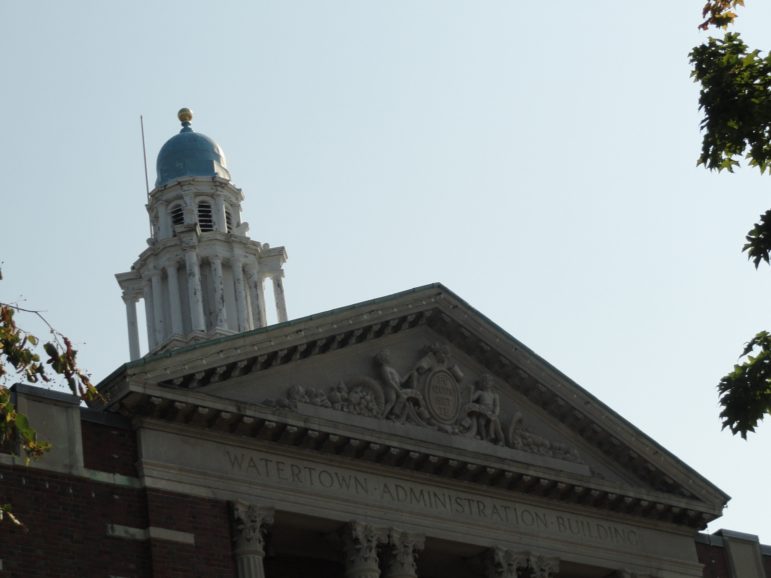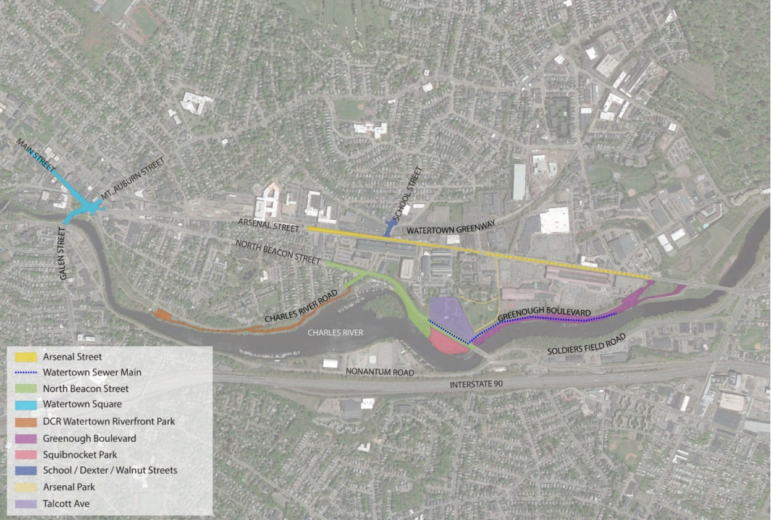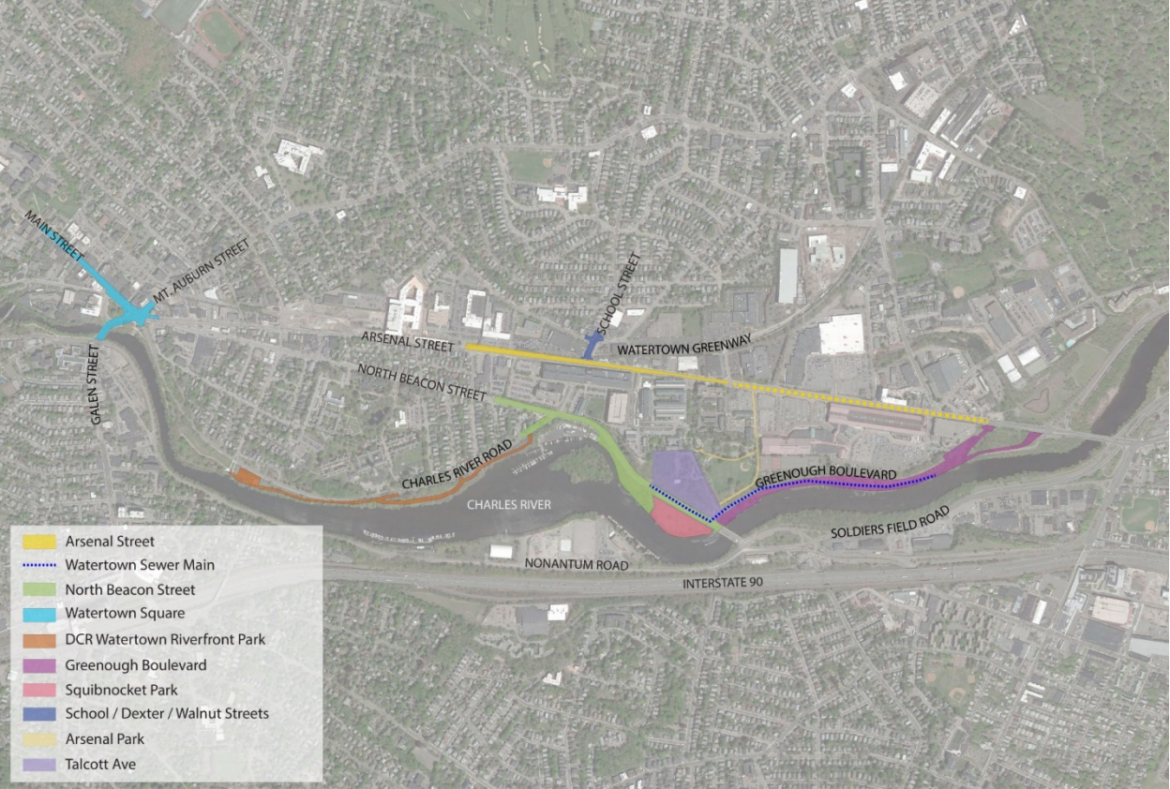
Charlie Breitrose
Watertown’s Town Hall.
After a marathon session, the Town Council unanimously approved a partnership with Athenahealth and the DCR that will bring $25 million in public infrastructure projects to the area in East Watertown around the company’s campus.
The funds to pay for 10 proposed projects come from the state via the I-Cubed program, which creates partnerships between public entities (the Town and the Department of Conservation and Recreation) and a private one (Athenahealth). The money comes from additional taxes created by Athena adding more jobs through its campus expansion, and will be used to pay for bonds issued by the state. The projects must be completed within 3 years of the issuance of the bonds.
While many residents and some on the Council said the Town would be crazy to pass up $25 million in free projects (or at least that won’t use Watertown residents’s tax dollars) others complained that the list of projects came forward with little public discussion about what made the list. Also, some worried about what happens if the projects are not finished within 3 years, or if there are cost overruns.
Resident John Labadini noted that some members of the Council campaigned for last fall’s Community Preservation Act ballot question, which added a 2 percent surcharge to property bills, saying that the town would be passing up free money from the state. If they opposed the I-Cubed money, he said it would be “paradoxical.” In addition there has been a push to get more benefits for the town from developers.
“How can anyone say they want to hold developers to a higher standard oppose this?” Labadini said. “There are 25 million reasons to vote yes on this.”
Resident Curtis Whitney applauded Town Manager Michael Driscoll for keeping property taxes down, and said the I-Cubed money would continue to help do so. In addition, he said Athenahealth, which is the town’s largest employer, is a great asset to the community.
Some Councilors said they did not like the fact that they had little input or information about the projects. Some residents agreed, including Jonathan Bockian who said that it was “shameful” that the Town administration and Town Council “took no steps to get public input” on the proposed projects.
Resident Sarah Ryan, who lives near Athenahealth, said while she likes the idea of the town getting millions in improvements, she has concerns with how the projects overseen by the company will work.
“Athena’s process with construction the last six months have not gone smoothly. There have been considerable difficulties,” Ryan said, said she was disappointed to see the I-Cubed projects went from concepts 14 months ago to detailed projects with no public involvement.
State Rep. John Lawn spoke on behalf of his colleagues representing Watertown in the State Legislature – Sen. Will Brownsberger and Rep. Jonathan Hecht – to advocate for approving the I-Cubed funds. He recalled how when he served as a Town Councilor, from 2006 to 2011, it was during the economic downturn. While the economy looks good right now, but he said that the Massachusetts state budget is in “dire straits.”
“(The economy) will not always be this good, and quite frankly (the state) does not have the money to do these things,” Lawn said.
The Projects
With the Council’s approval, the I-Cubed package will be sent to the Executive Office of Administration and Finance (A&F) which will have 60 days to review the projects and give their approval, said Stephen DeCourcey, who is serving as town attorney for the I-Cubed projects.
The officials at A&F will look at the projects, make sure that they believe they can be done for the proposed amount and within three years, Assistant Town Manager Steve Magoon said. If they do not think one or more of the projects meet those qualifications the projects will drop out of the I-Cubed agreement.
After receiving A&F’s approval, the Town, the DCR, Athenahealth and A&F must come up with an IDAA (infrastructure development assistance agreement), DeCourcey said. The Council will once again be asked to approve this agreement.
To be part of I-Cubed, the projects have to contribute to economic development, in this case with the expansion of Athena’s campus. Therefore they must impact the campus. Most of them are right around the Arsenal on the Charles, but are as far away as Watertown Square.
The list of projects include:
- $7.5 million – Arsenal Street: roadway and sidewalk improvements, upgraded traffic lights and timing
- $900,000 – Sewer improvements on North Beacon Street and Greenough Boulevard
- $6.3 million – Roadway improvements to North Beacon, a cycling and pedestrian path, signal upgrades
- $1.7 million – Watertown Square repaving, sidewalk improvements, upgrades to traffic, pedestrian signals and timing, and realigning Charles River Road
- $700,000 – Completing the improvements of the Watertown Riverfront Park on the north bank of the Charles River
- $1.7 million – Greenough Boulevard: bicycle and pedestrian path upgrades, improvements to the roadway and signal upgrades (including a traffic light at Greenough and North Beacon)
- $2.7 million – Squibnocket Park: adding a canoe/kayak launch, a boardwalk and river overlook, and landscaping
- $400,000 – School Street/Dexter Avenue/Walnut Street: sight-line improvements and curb realignments
- $400,000 – Arsenal Park: extension of the Community Path through the park
- $2.7 million – Drainage and parking improvement on Talcott Avenue near the Commander’s Mansion, cosmetic improvements to the Mansion and grounds and realignment of Talcott Avenue, and possibly linking it to either North Beacon or Greenough
(See more details of the projects here.)

A map showing the areas where the proposed I-Cubed projects would be located.
The projects were only touched upon slightly during the discussion. Each one will still have to go through the normal Town approvals, and at that time the public will have a chance to discuss the projects, Magoon said.
Council Concerns
A number of Councilors brought up concerns about whether the Town will be left holding the bag if the new jobs at Athenahealth do not materialize, or if projects fall behind or go over budget.
Councilor Angeline Kounelis said in May she has pressed the Town and others when she read that the financial risk was “minimal,” and was concerned when she could not get an answer for what that would mean. She said she was happy to see that the proposal now says there is “no risk” to the Town.
Under the I-Cubed rules, the public entity could be responsible if the economic growth targets are not met, and do not cover the cost of the bonds, DeCourcey said. However, Athenahealth agreed to allow the Town to put a levy on their property to cover any shortfall in taxes created. This levy would take precedent over mortgages and other fees, DeCourcey said. If Athena changes hands or the property is sold, the agreement goes with the property.
Councilor Tony Palomba wondered what would happen if the projects do not get finished in the 3 year time. Magoon said he believes the state will give some leeway.
“If we work diligently and we are close to being on time there is no reason we cannot go over 3 years,” Magoon said. “If we are not performing, not progressing, then the money is in jeopardy – just for that item.”
Scott Susko, an attorney representing Athena, said the money must be spent within 3 years, so projects could go longer, and he said there are exceptions for extraordinary events such as a bad winter or an earthquake.
When Palomba asked about what happens if a project ends up costing more than expected, Susko said that how that will be handled will be negotiated as part of the IDAA. He added that Athena’s position is that they will not spend more than $25 million on the project.
Multiple Councilors also worried about the Department of Public Works and the Department of Community Development and Planning being able to handle all the projects in such a short amount of time – and while dealing with other projects such as the Arsenal Yards.
DPW Superintendent Gerry Mee said that he is confident he and his staff can handle the work.
“We have no intention of dropping projects to do these projects with Athena,” Mee said. “It’s going to be incredibly difficult, but I did it in the past when I was on my own, and didn’t have a Town Engineer or Director of Administration and Finance.”
In May, Councilor Aaron Dushku wondered if some of the money could have been spent on other items, such as helping to improve the MTBA buses on Arsenal Street or funding the Watertown TMA shuttle, but was told those do not qualify. Thursday night he asked if the money could have been spend on the parking garage being built by Athena, and in turn free up money to be spent on things like public transportation.
Magoon said the money cannot be spent on Athena’s property. Susko added that as a publicly traded company, Athena could not justify spending company funds on something not directly benefiting them.
Councilor Susan Falkoff said it appears that some of the I-Cubed money is paying for items that were already part of the mitigation projects promised to be done by Athena, or other nearby projects, when they got approval from the Town. Magoon said the mitigation for Athena will be largely included in the I-Cubed projects, but some of the projects were originally mitigation work from other projects. The money that would have come from projects besides Athena’s will be diverted to other projects, Magoon said.
Several Councilors said they were disappointed with the lack of input from the public before the set of projects were presented to the Council, and even that the Council was an afterthought. Councilor Michael Dattoli said he supports getting the $25 million from the state but it is difficult to approve something that he has not had a chance to comment on the project.
Councilor Lisa Feltner said she thinks public input is vital.
“Public input doesn’t mean everyone gets their way or they are designing the project,” Feltner said. “The public process is very important.”
Kounelis said she believes communication with Athena will be a key to the project, and that someone at the company must respond in a timely manner to question and concerns.
“You are a company that is developing a major project in our community,” Kounelis said. “There needs to be open communication, not just ‘look it up on our website.’ The door and windows need to be open (to communication).”
Councilor Ken Woodland said that the projects did not just come out of thin air. He noted that they were chosen from planning documents, such as the Watertown Comprehensive Plan and the DCR’s Charles River Basin Master Plan – which were created after multiple public meetings.
Council Vice President Vincent Piccirilli said that the Council had its chance to push for more public meetings. In the time since it was first presented to the Council, he said, “any of us could have asked for more information. None of us did.”
He added that there has never been a mitigation project like this in Watertown, and that there will be opportunities for public input as the concepts of the projects are turned into detailed plans.
Town Council President Mark Sideris said that Watertown is in an envious position.
“Any city or town in the Commonwealth would love to have an opportunity to have $25 million in infrastructure improvements,” Sideris said. “And I think every community in Massachusetts would want to have Athena in their community, paying taxes and their employees living here.”
He acknowledged that the process could have gone more smoothly.
“There have been some difficulties, I think that is part of the learning process,” Sideris said.
The I-Cube proposal needed the support of two-thirds of the Council to pass, and it passed 9-0.
Next Steps
After the approval, the Council approved a set of next steps, including those asking for more community involvement. Councilors voted to have Sideris send a letter to the DCR asking for the agency to have a public meeting about the projects on their properties.
In addition, the Council’s Public Works subcommittee will hold a meeting to discuss projects impacting roadways in Watertown, including Watertown Square, the Walnut Street/School Street intersection, opening the Talcott Avenue entrance and North Beacon Street.
Finally, the Council’s Economic Development and Planning subcommittee will discuss the preliminary IDAA agreement before it goes to the full Council for final approval.

The article states that the Steve Magoon said that the original mitigation money from Athena “can be redirected to other projects.” Is this correct I thought the original mitigation money was now being provided by the state as part of the 25 million in the I Cube money and that Athena was now providing guarantees as their part in this process.
What I heard in the discussion was that the money can be redirected. The Councilor asked specifically about that.
Bob, here is an update. You are right about the mitigation projects from Athena. My apologies. They will be part of the I-Cubed work. I have changed that in the article. Steve Magoon said mitigation projects that were supposed to be part of other developments that are now in I-Cubed will have the money redirected.